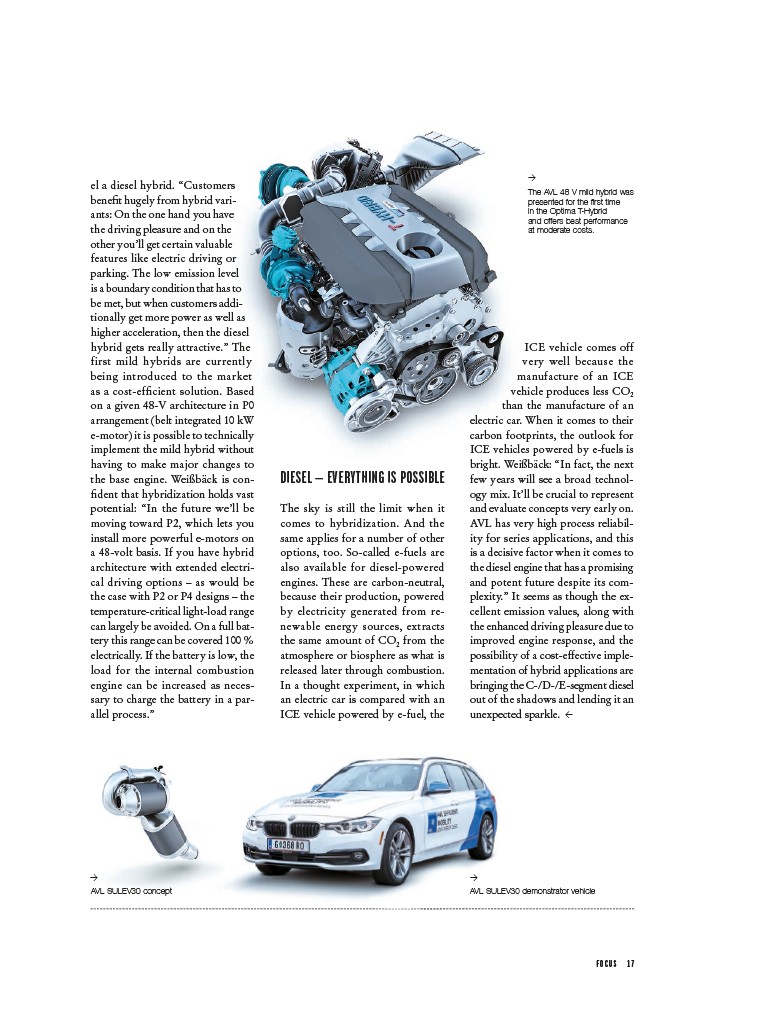
>
The AVL 48 V mild hybrid was
presented for the fi rst time
in the Optima T-Hybrid
and offers best performance
at moderate costs.
F O C U S 1 7
el a diesel hybrid. “Customers
benefi t hugely from hybrid variants:
On the one hand you have
the driving pleasure and on the
other you’ll get certain valuable
features like electric driving or
parking. The low emission level
is a boundary condition that has to
be met, but when customers additionally
get more power as well as
higher acceleration, then the diesel
hybrid gets really attractive.” The
first mild hybrids are currently
being introduced to the market
as a cost-effi cient solution. Based
on a given 48-V architecture in P0
arrangement (belt integrated 10 kW
e-motor) it is possible to technically
implement the mild hybrid without
having to make major changes to
the base engine. Weißbäck is confi
dent that hybridization holds vast
potential: “In the future we’ll be
moving toward P2, which lets you
install more powerful e-motors on
a 48-volt basis. If you have hybrid
architecture with extended electrical
driving options – as would be
the case with P2 or P4 designs – the
temperature-critical light-load range
can largely be avoided. On a full battery
this range can be covered 100 %
electrically. If the battery is low, the
load for the internal combustion
engine can be increased as necessary
to charge the battery in a parallel
process.”
DIESEL – EVERYTHING IS POSSIBLE
The sky is still the limit when it
comes to hybridization. And the
same applies for a number of other
options, too. So-called e-fuels are
also available for diesel-powered
engines. These are carbon-neutral,
because their production, powered
by electricity generated from renewable
energy sources, extracts
the same amount of CO2 from the
atmosphere or biosphere as what is
released later through combustion.
In a thought experiment, in which
an electric car is compared with an
ICE vehicle powered by e-fuel, the
ICE vehicle comes off
very well because the
manufacture of an ICE
vehicle produces less CO2
than the manufacture of an
electric car. When it comes to their
carbon footprints, the outlook for
ICE vehicles powered by e-fuels is
bright. Weißbäck: “In fact, the next
few years will see a broad technology
mix. It’ll be crucial to represent
and evaluate concepts very early on.
AVL has very high process reliability
for series applications, and this
is a decisive factor when it comes to
the diesel engine that has a promising
and potent future despite its complexity.”
It seems as though the excellent
emission values, along with
the enhanced driving pleasure due to
improved engine response, and the
possibility of a cost-effective implementation
of hybrid applications are
bringing the C-/D-/E-segment diesel
out of the shadows and lending it an
unexpected sparkle. <
>
AVL SULEV30 concept
>
AVL SULEV30 demonstrator vehicle